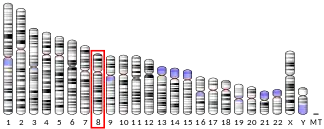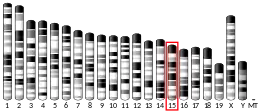Autotaxin, also known as ectonucleotide pyrophosphatase/phosphodiesterase family member 2 (E-NPP 2), is an enzyme that in humans is encoded by the ENPP2 gene.[5][6]
Function
Autotaxin is a secreted enzyme important for generating the lipid signaling molecule lysophosphatidic acid (LPA). Autotaxin has lysophospholipase D activity that converts lysophosphatidylcholine into LPA.
Autotaxin was originally identified as a tumor cell-motility-stimulating factor; later it was shown to be LPA (which signals through lysophospholipid receptors), the lipid product of the reaction catalyzed by autotaxin, which is responsible for its effects on cell-proliferation.
The protein encoded by this gene functions as a phosphodiesterase. Autotaxin is secreted and further processed to make the biologically active form. Several alternatively spliced transcript variants have been identified. Autotaxin is able to cleave the phosphodiester bond between the α and the β position of triphosphate nucleotides, acting as an ectonucleotide phosphodiesterase producing pyrophosphate, as most members of the ENPP family. Importantly, autotaxin also acts as phospholipase, catalyzing the removal of the head group of various lysolipids. The physiological function of autotaxin is the production of the signalling lipid lysophosphatidic acid (LPA) in extracellular fluids. LPA evokes growth factor-like responses including stimulation of cell proliferation and chemotaxis. This gene product stimulates the motility of tumor cells, has angiogenic properties, and its expression is up-regulated in several kinds of tumours.[6] Also, autotaxin and LPA are involved in numerous inflammatory-driven diseases such as asthma and arthritis.[7] Physiologically, LPA helps promote wound healing responses to tissue damage. Under normal circumstances, LPA negatively regulates autotaxin transcription, but in the context of wound repair, cytokines induce autotaxin expression to increase overall LPA concentrations.[8]
As a drug target
Various small molecule inhibitors of autotaxin have been developed for clinical applications. A specific inhibitor against idiopathic pulmonary fibrosis showed promising results in a phase II trial that ended in May 2018.[9] A DNA aptamer inhibitor of Autotaxin has also been described.[10]
Recently, it has been shown that THC is also a partial autotaxin inhibitor, with an apparent IC50 of 407 ± 67 nM for the ATX-gamma isoform.[11] THC was also co-crystallized with autotaxin, deciphering the binding interface of the complex. These results might explain some of the effects of THC on inflammation and neurological diseases, since autotaxin is responsible of LPA generation, a key lipid mediator involved in numerous diseases and physiological processes. However, clinical trials need to be performed in order to assess the importance of ATX inhibition by THC during medicinal cannabis consumption. Development of cannabinoid inspired autotaxin inhibitors could also be an option in the future.
Structure
The crystal structures of rat and mouse autotaxin[12] have been solved. In each case, the apo structure has been solved along with those of product- or inhibitor-bound complexes. Both proteins consist of 4 domains, including 2 N-terminal somatomedin-B-like (SMB) domains which may be involved in cell-surface localisation. The catalytic domain follows and contains a deep hydrophobic pocket in which the lipid substrate binds. At the C-terminus is the inactive nuclease domain which may function to aid protein stability.
See also
References
- 1 2 3 GRCh38: Ensembl release 89: ENSG00000136960 - Ensembl, May 2017
- 1 2 3 GRCm38: Ensembl release 89: ENSMUSG00000022425 - Ensembl, May 2017
- ↑ "Human PubMed Reference:". National Center for Biotechnology Information, U.S. National Library of Medicine.
- ↑ "Mouse PubMed Reference:". National Center for Biotechnology Information, U.S. National Library of Medicine.
- ↑ Kawagoe H, Soma O, Goji J, Nishimura N, Narita M, Inazawa J, Nakamura H, Sano K (November 1995). "Molecular cloning and chromosomal assignment of the human brain-type phosphodiesterase I/nucleotide pyrophosphatase gene (PDNP2)". Genomics. 30 (2): 380–4. doi:10.1006/geno.1995.0036. PMID 8586446.
- 1 2 "Entrez Gene: ENPP2 ectonucleotide pyrophosphatase/phosphodiesterase 2 (autotaxin)".
- ↑ Benesch MG, Ko YM, McMullen TP, Brindley DN (August 2014). "Autotaxin in the crosshairs: taking aim at cancer and other inflammatory conditions". FEBS Letters. 588 (16): 2712–27. doi:10.1016/j.febslet.2014.02.009. PMID 24560789. S2CID 35544825.
- ↑ Benesch MG, Zhao YY, Curtis JM, McMullen TP, Brindley DN (June 2015). "Regulation of autotaxin expression and secretion by lysophosphatidate and sphingosine 1-phosphate". Journal of Lipid Research. 56 (6): 1134–44. doi:10.1194/jlr.M057661. PMC 4442871. PMID 25896349.
- ↑ Clinical trial number NCT02738801 for "Study to Assess Safety, Tolerability, Pharmacokinetic and Pharmacodynamic Properties of GLPG1690" at ClinicalTrials.gov
- ↑ Kato K, Ikeda H, Miyakawa S, Futakawa S, Nonaka Y, Fujiwara M, Okudaira S, Kano K, Aoki J, Morita J, Ishitani R, Nishimasu H, Nakamura Y, Nureki O (May 2016). "Structural basis for specific inhibition of Autotaxin by a DNA aptamer". Nature Structural & Molecular Biology. 23 (5): 395–401. doi:10.1038/nsmb.3200. PMID 27043297. S2CID 24948842.
- ↑ Eymery MC, McCarthy AA, Hausmann J (February 2023). "Linking medicinal cannabis to autotaxin–lysophosphatidic acid signaling". Life Science Alliance. 6 (2): e202201595. doi:10.26508/lsa.202201595. ISSN 2575-1077. PMC 9834664. PMID 36623871.
- ↑ Nishimasu H, Okudaira S, Hama K, Mihara E, Dohmae N, Inoue A, Ishitani R, Takagi J, Aoki J, Nureki O (February 2011). "Crystal structure of autotaxin and insight into GPCR activation by lipid mediators". Nature Structural & Molecular Biology. 18 (2): 205–12. doi:10.1038/nsmb.1998. PMID 21240269. S2CID 6336916.
Further reading
- Tokumura A, Majima E, Kariya Y, Tominaga K, Kogure K, Yasuda K, Fukuzawa K (October 2002). "Identification of human plasma lysophospholipase D, a lysophosphatidic acid-producing enzyme, as autotaxin, a multifunctional phosphodiesterase". The Journal of Biological Chemistry. 277 (42): 39436–42. doi:10.1074/jbc.M205623200. PMID 12176993.
- Umezu-Goto M, Kishi Y, Taira A, Hama K, Dohmae N, Takio K, Yamori T, Mills GB, Inoue K, Aoki J, Arai H (July 2002). "Autotaxin has lysophospholipase D activity leading to tumor cell growth and motility by lysophosphatidic acid production". The Journal of Cell Biology. 158 (2): 227–33. doi:10.1083/jcb.200204026. PMC 2173129. PMID 12119361.
- Stracke ML, Krutzsch HC, Unsworth EJ, Arestad A, Cioce V, Schiffmann E, Liotta LA (February 1992). "Identification, purification, and partial sequence analysis of autotaxin, a novel motility-stimulating protein". The Journal of Biological Chemistry. 267 (4): 2524–9. doi:10.1016/S0021-9258(18)45911-X. PMID 1733949.
- Stracke ML, Arestad A, Levine M, Krutzsch HC, Liotta LA (August 1995). "Autotaxin is an N-linked glycoprotein but the sugar moieties are not needed for its stimulation of cellular motility". Melanoma Research. 5 (4): 203–9. doi:10.1097/00008390-199508000-00001. PMID 7496154. S2CID 8300784.
- Murata J, Lee HY, Clair T, Krutzsch HC, Arestad AA, Sobel ME, Liotta LA, Stracke ML (December 1994). "cDNA cloning of the human tumor motility-stimulating protein, autotaxin, reveals a homology with phosphodiesterases". The Journal of Biological Chemistry. 269 (48): 30479–84. doi:10.1016/S0021-9258(18)43838-0. PMID 7982964.
- Lee HY, Murata J, Clair T, Polymeropoulos MH, Torres R, Manrow RE, Liotta LA, Stracke ML (January 1996). "Cloning, chromosomal localization, and tissue expression of autotaxin from human teratocarcinoma cells". Biochemical and Biophysical Research Communications. 218 (3): 714–9. doi:10.1006/bbrc.1996.0127. PMID 8579579.
- Lee HY, Clair T, Mulvaney PT, Woodhouse EC, Aznavoorian S, Liotta LA, Stracke ML (October 1996). "Stimulation of tumor cell motility linked to phosphodiesterase catalytic site of autotaxin". The Journal of Biological Chemistry. 271 (40): 24408–12. doi:10.1074/jbc.271.40.24408. PMID 8798697.
- Clair T, Lee HY, Liotta LA, Stracke ML (January 1997). "Autotaxin is an exoenzyme possessing 5'-nucleotide phosphodiesterase/ATP pyrophosphatase and ATPase activities". The Journal of Biological Chemistry. 272 (2): 996–1001. doi:10.1074/jbc.272.2.996. PMID 8995394.
- Dias Neto E, Correa RG, Verjovski-Almeida S, Briones MR, Nagai MA, da Silva W, Zago MA, Bordin S, Costa FF, Goldman GH, Carvalho AF, Matsukuma A, Baia GS, Simpson DH, Brunstein A, de Oliveira PS, Bucher P, Jongeneel CV, O'Hare MJ, Soares F, Brentani RR, Reis LF, de Souza SJ, Simpson AJ (March 2000). "Shotgun sequencing of the human transcriptome with ORF expressed sequence tags". Proceedings of the National Academy of Sciences of the United States of America. 97 (7): 3491–6. Bibcode:2000PNAS...97.3491D. doi:10.1073/pnas.97.7.3491. PMC 16267. PMID 10737800.
- Nam SW, Clair T, Kim YS, McMarlin A, Schiffmann E, Liotta LA, Stracke ML (September 2001). "Autotaxin (NPP-2), a metastasis-enhancing motogen, is an angiogenic factor". Cancer Research. 61 (18): 6938–44. PMID 11559573.
- Umezu-Goto M, Kishi Y, Taira A, Hama K, Dohmae N, Takio K, Yamori T, Mills GB, Inoue K, Aoki J, Arai H (July 2002). "Autotaxin has lysophospholipase D activity leading to tumor cell growth and motility by lysophosphatidic acid production". The Journal of Cell Biology. 158 (2): 227–33. doi:10.1083/jcb.200204026. PMC 2173129. PMID 12119361.
- Tokumura A, Majima E, Kariya Y, Tominaga K, Kogure K, Yasuda K, Fukuzawa K (October 2002). "Identification of human plasma lysophospholipase D, a lysophosphatidic acid-producing enzyme, as autotaxin, a multifunctional phosphodiesterase". The Journal of Biological Chemistry. 277 (42): 39436–42. doi:10.1074/jbc.M205623200. PMID 12176993.
- Jung ID, Lee J, Yun SY, Park CG, Choi WS, Lee HW, Choi OH, Han JW, Lee HY (December 2002). "Cdc42 and Rac1 are necessary for autotaxin-induced tumor cell motility in A2058 melanoma cells". FEBS Letters. 532 (3): 351–6. doi:10.1016/S0014-5793(02)03698-0. PMID 12482591. S2CID 19821754.
- Yang SY, Lee J, Park CG, Kim S, Hong S, Chung HC, Min SK, Han JW, Lee HW, Lee HY (2003). "Expression of autotaxin (NPP-2) is closely linked to invasiveness of breast cancer cells". Clinical & Experimental Metastasis. 19 (7): 603–8. doi:10.1023/A:1020950420196. PMID 12498389. S2CID 25181446.
- Gijsbers R, Aoki J, Arai H, Bollen M (March 2003). "The hydrolysis of lysophospholipids and nucleotides by autotaxin (NPP2) involves a single catalytic site". FEBS Letters. 538 (1–3): 60–4. doi:10.1016/S0014-5793(03)00133-9. PMID 12633853. S2CID 38206060.
- Koh E, Clair T, Woodhouse EC, Schiffmann E, Liotta L, Stracke M (May 2003). "Site-directed mutations in the tumor-associated cytokine, autotaxin, eliminate nucleotide phosphodiesterase, lysophospholipase D, and motogenic activities". Cancer Research. 63 (9): 2042–5. PMID 12727817.
- Kehlen A, Englert N, Seifert A, Klonisch T, Dralle H, Langner J, Hoang-Vu C (May 2004). "Expression, regulation and function of autotaxin in thyroid carcinomas". International Journal of Cancer. 109 (6): 833–8. doi:10.1002/ijc.20022. PMID 15027116. S2CID 25281125.
- Boucher J, Quilliot D, Pradères JP, Simon MF, Grès S, Guigné C, Prévot D, Ferry G, Boutin JA, Carpéné C, Valet P, Saulnier-Blache JS (March 2005). "Potential involvement of adipocyte insulin resistance in obesity-associated up-regulation of adipocyte lysophospholipase D/autotaxin expression". Diabetologia. 48 (3): 569–77. doi:10.1007/s00125-004-1660-8. PMC 1885462. PMID 15700135.
External links
- Human ENPP2 genome location and ENPP2 gene details page in the UCSC Genome Browser.






